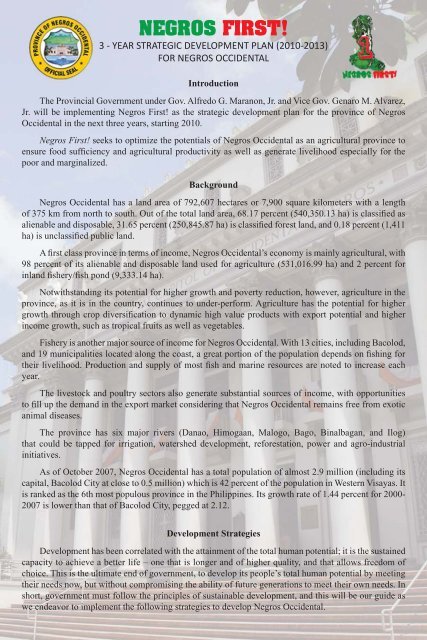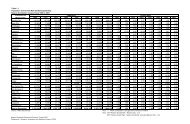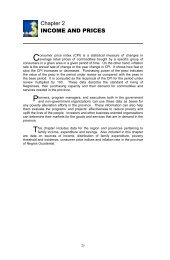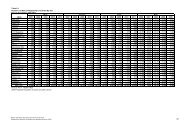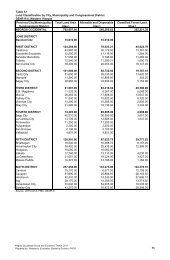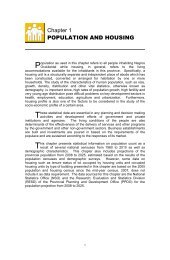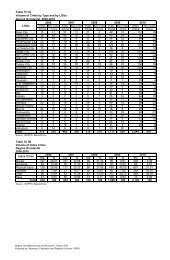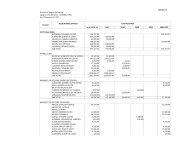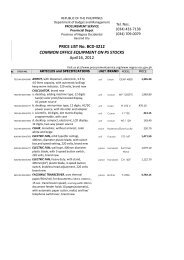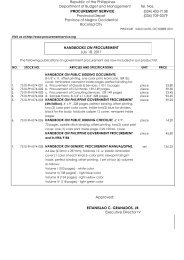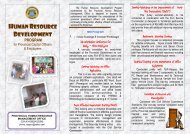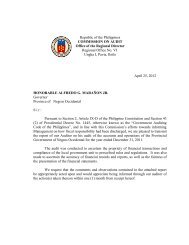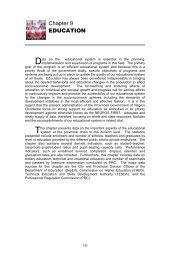DIRECTORY 2011 Edited 4-11.indd - Negros Occidental
DIRECTORY 2011 Edited 4-11.indd - Negros Occidental
DIRECTORY 2011 Edited 4-11.indd - Negros Occidental
Create successful ePaper yourself
Turn your PDF publications into a flip-book with our unique Google optimized e-Paper software.
NEGROS FIRST!3 - YEAR STRATEGIC DEVELOPMENT PLAN (2010-2013)FOR NEGROS OCCIDENTALIntroductionThe Provincial Government under Gov. Alfredo G. Maranon, Jr. and Vice Gov. Genaro M. Alvarez,Jr. will be implementing <strong>Negros</strong> First! as the strategic development plan for the province of <strong>Negros</strong><strong>Occidental</strong> in the next three years, starting 2010.<strong>Negros</strong> First! seeks to optimize the potentials of <strong>Negros</strong> <strong>Occidental</strong> as an agricultural province toensure food sufciency and agricultural productivity as well as generate livelihood especially for thepoor and marginalized.Background<strong>Negros</strong> <strong>Occidental</strong> has a land area of 792,607 hectares or 7,900 square kilometers with a lengthof 375 km from north to south. Out of the total land area, 68.17 percent (540,350.13 ha) is classied asalienable and disposable, 31.65 percent (250,845.87 ha) is classied forest land, and 0.18 percent (1,411ha) is unclassied public land.A rst class province in terms of income, <strong>Negros</strong> <strong>Occidental</strong>’s economy is mainly agricultural, with98 percent of its alienable and disposable land used for agriculture (531,016.99 ha) and 2 percent forinland shery/sh pond (9,333.14 ha).Notwithstanding its potential for higher growth and poverty reduction, however, agriculture in theprovince, as it is in the country, continues to under-perform. Agriculture has the potential for highergrowth through crop diversication to dynamic high value products with export potential and higherincome growth, such as tropical fruits as well as vegetables.Fishery is another major source of income for <strong>Negros</strong> <strong>Occidental</strong>. With 13 cities, including Bacolod,and 19 municipalities located along the coast, a great portion of the population depends on shing fortheir livelihood. Production and supply of most sh and marine resources are noted to increase eachyear.The livestock and poultry sectors also generate substantial sources of income, with opportunitiesto ll up the demand in the export market considering that <strong>Negros</strong> <strong>Occidental</strong> remains free from exoticanimal diseases.The province has six major rivers (Danao, Himogaan, Malogo, Bago, Binalbagan, and Ilog)that could be tapped for irrigation, watershed development, reforestation, power and agro-industrialinitiatives.As of October 2007, <strong>Negros</strong> <strong>Occidental</strong> has a total population of almost 2.9 million (including itscapital, Bacolod City at close to 0.5 million) which is 42 percent of the population in Western Visayas. Itis ranked as the 6th most populous province in the Philippines. Its growth rate of 1.44 percent for 2000-2007 is lower than that of Bacolod City, pegged at 2.12.Development StrategiesDevelopment has been correlated with the attainment of the total human potential; it is the sustainedcapacity to achieve a better life – one that is longer and of higher quality, and that allows freedom ofchoice. This is the ultimate end of government, to develop its people’s total human potential by meetingtheir needs now, but without compromising the ability of future generations to meet their own needs. Inshort, government must follow the principles of sustainable development, and this will be our guide aswe endeavor to implement the following strategies to develop <strong>Negros</strong> <strong>Occidental</strong>.


